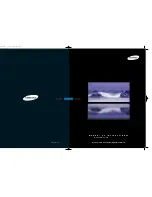
7-4
Random Access Adjustment Mode
5975398 BARCODATA 3200 110797
Select with or
<ENTER> to toggle
or to change value
<EXIT> to return
Sync
pulse
Clamp
pulse
Clamp
delay
Clamp
width
Example for clamp position [trailing]
EDIT FILE OPTIONS
Source number
1
Clamp position
[leading]
Clamp width
[1]
Field polarity inverted
[no]
Vertical refresh
[sync]
Vert. sync polarity
[leading]
CONFIRM
EDIT FILE
Save changes to file
xga.c30?
<ENTER> to confirm
<EXIT> to return
mismeasurement, use the ENTER key to toggle between [On] and
[Off]. (for interlaced images, 1 frame contains 2 fields).
Read AMDS
AMDS = automatic mode detection & synchronisation
During the installation of a file with LOAD, the system automatically
measured the horizontal period, the total vertical lines and the
interlaced mode.
When selecting Read AMDS, the system remeasures the above
indicated items.
Options
Source number
: The source number of a non-active source can be
changed to any other source number. This makes it possible to create
a file for future source numbers.
Clamp position
: Clamping determines the black level of the signal.
The clamp pulse can be related to the leading or the trailing edge of
the sync pulse. Use the
ENTER
key to toggle between [leading] and
[trailing].
Clamp width
: The width of the clamp pulse [1 or 2]
[1] : narrow clamp pulse
[2] : wide clamp pulse
Field polarity inverted
The field polarity function is used for interlaced images. Both rasters
of the image could be shifted in a wrong way (double lines are visilble
in the image). This can be corrected by forcing the field polarity to
[yes].
Use the
ENTER
key to toggle between [yes] and [no].
Vertical refresh [sync/async] : The way of updating the image
information on the LCD panels.
* For sources with a vertical frequency up to 60 Hz : the vertical
refresh rate is the same as the vertical frequency of the incoming
source. This is a necessity to project moving images without 'motion
artefacts'. For stationary images with a vertical frequency up to 60 Hz
it is still possible to use asynchronous refresh. When loading Pal,
Secam, NTSC-files syncronous mode is default, for all other sources
below 60 Hz asyncronous mode is default.
* For sources with a vertical frequency higher that 60 Hz : the vertical
refresh is different than the vertical frequency of the incoming source.
Synchronous refresh cannot be used.
Vertical sync polarity : [leading] or [trailing]
The vertical refresh can be synchronised with the leading sync edge
or trailing sync edge. Default on [leading].
Toggling to [trailing] is only necessary for special applications where
the trailing edge of the sync signal has to be taken as a reference.
Use the ENTER key to toggle between [leading] or [trailing]
Press EXIT to leave the Edit File Option menu.
A 'Confirm Edit File' menu will be displayed.
Press ENTER to confirm and to save the new settings or EXIT to
return without saving the new entered settings.
















































